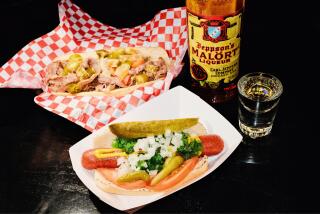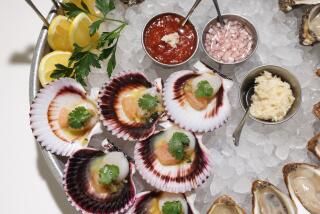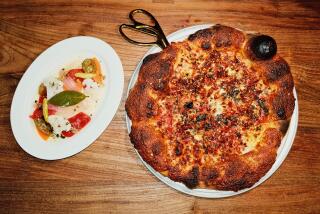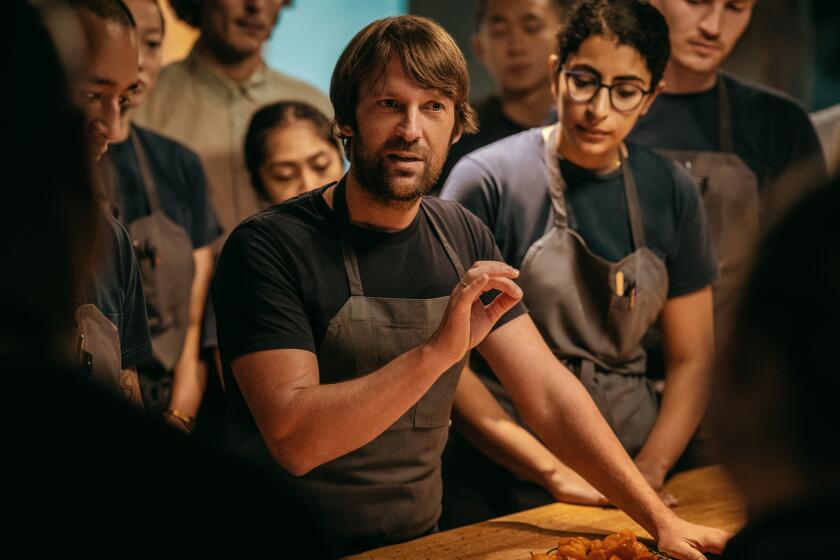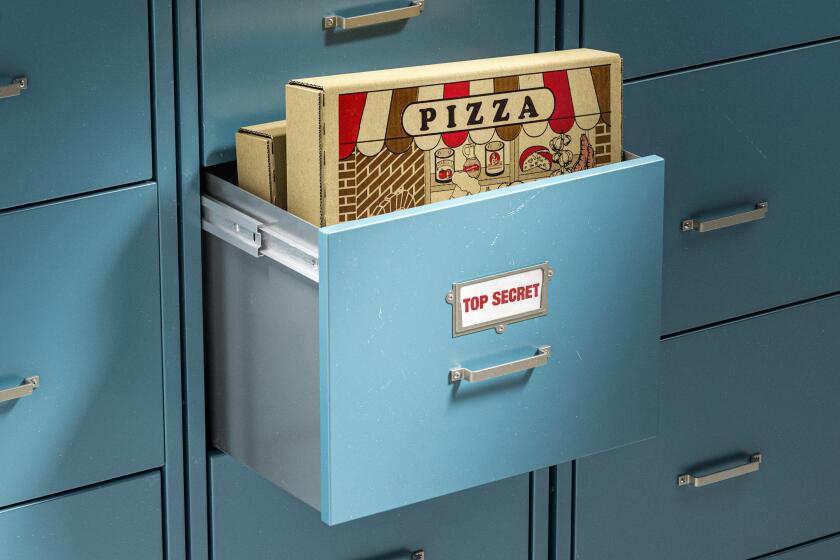MARKETS : Three Hot Bakers
The revival of a well-crafted loaf can be credited to a handful of American bakers, whose small-scale production of artisanal bread is the sort that once thrived everywhere in Europe. Their fragrant loaves--rich dark ryes, crackly crusted baguettes and mellow sourdoughs--are the sort that made us once revere bread as the “staff of life.”
It’s been more than six years since Nancy Silverton opened La Brea Bakery and sparked the excitement for sourdough bread in this city. These days, she isn’t alone. I tracked down three Southern California sourdough bakers, each with a style as unique as the baker’s own signature. And yet their breads have one thing in common: They are shaped by hand and leavened by an ancient method based on slow-fermenting natural yeast starters in place of faster-acting commercial yeast.
This slow leavening process develops character in the breads. The results are deeper, more complex nutty flavors, a moist crumb with a springier texture, and hearty crusts that keep the loaves fresh without refrigeration (and without using freshness-protecting additives).
*
I kept hearing about the fabulous bread you could buy at the Hollywood Farmers Market. “It’s amazing stuff--one guy bakes about a dozen kinds himself,” said a fan who brought me the green olive bread with walnuts and the garlic-chive bread with baked garlic. The loaves were impressive, with sturdy, beautifully blistered crusts and a distinctive, cheese-like tang.
As it happens, the baker, Jack Bezjian, is also the proprietor of Bezjian’s, a well-known East Hollywood Armenian market. When I call, he invites me to watch him at work, and I arrive long before the doors open for business.
An assistant lets me in. I make my way past shelves crowded with exotic-looking jars, stacks of heavy bags filled with rice and several long deli cases, then through a narrow passageway to a cluttered bakery area.
Curiously, the huge tunnel oven that dominates the room sits cold and unused alongside an enormous (and also unused) mechanical dough divider and loaf shaper. All around are vats and jars filled with mysterious-looking bubbling batters. “I’m over here,” says a voice coming from behind a multi-tiered rack stacked with variously shaped unbaked loaves.
From behind the rack steps Bezjian, an electric carving knife in his hand. He waves me over and proceeds to slash into the loaves, giving them different markings. Among the thicket of equipment, only a single large rack oven is heating up as Bezjian readies the hand-shaped loaves.
“I’ve been baking for 30 years,” he tells me, intent on his work. “We used to make our own pita bread here [pointing to the unused equipment], and I started my experiments to see if I could make a better-tasting pita. We quit doing that because there was too much competition from the commercial pita bakeries. Then I got interested in baking this kind of bread.”
Bezjian says he’s tried all sorts of yeast cultures. The one he uses most often now has the special balance of natural yeast and lactobacillus he favors. He lets the dough ferment for several days, allowing it to rise very slowly in a cool environment, rather like aging wine. This, he says, develops the best taste because all the flavor-producing enzymes and yeast byproducts have time to permeate the dough. You can’t leaven ordinary straight dough like this because it just dies after a few days in the retarder.
He continues to expound on the minutiae of yeast fermentation, like a talking textbook of leavening science, working his way through the beneficial synergism of lactobacillus and yeast. Good water, he says, pointing to his reverse osmosis purifier, is very important, because the chemicals in tap water can suppress yeast growth.
But artisanal bread baking is not scientific. “Making this bread is trial and error every day,” Bezjian says. “Like other living things, the dough has its idiosyncrasies, and these change daily. You can’t just knead for a certain amount of minutes. You have to feel the dough to know when it’s mixed enough, when it’s kneaded enough and has risen enough [he pokes at a loaf]. The humidity of the flour, the air and even added ingredients can change things.”
Everything you add to the dough makes it react differently, he says. “I was using white onions in the zucchini bread and it didn’t work at all. And watercress--the yeast doesn’t like it and won’t rise if you add it to the dough too early.”
It’s not surprising Bezjian has such a fascination with the scientific aspects of bread baking--he studied engineering for five years. But instead of pursuing that career he remained in the family-owned store doing the baking.
“My first Western-style loaves were pretty strange,” he says. “Too sour. I called them sour bread.” Many customers bought them anyway, so he was encouraged to keep on trying. He is still experimenting. Sometimes his flavorings seem too wild to be true--I don’t mean the date-pecan loaf or the popular cilantro-garlic, or even the delicious Moroccan olive with thyme and orange peel, rather the offbeat combinations like tamarind with sliced bananas or the Spanish saffron with lemon grass and curry leaf (which does not taste in any way like curry powder).
As baroque as these may sound, Bezjian uses additions so subtly they never overwhelm the bread. His plain loaves are exemplary. But you never know what new experiment you’ll find.
* Bezjian’s, 4715 Santa Monica Blvd. Los Angeles. (213) 663-8608. Open daily, 10 a.m. to 7 p.m. Breads available at the store and at the Hollywood Farmers Market, Sundays 8:30 a.m. to 1 p.m., just south of Hollywood Boulevard at Ivar and Selma Avenues.
*
“When he’s in town to teach classes, Giuliano Bugialli always insists on going to Baducco’s for bread,” says my friend the cooking school owner. I remember that Baducco’s has a top-notch Italian salumeria , though I haven’t been there in many years, but I don’t recall much about the bread. I decide to go see what makes cookbook author Bugialli such a devotee.
Although the store has maintained its own bakery since it opened 16 years ago in Westlake Village, it wasn’t until six years ago that it started baking what it calls “natural levitation breads.” In Italy the leavening term would be lievito naturale .
“We wanted to have the kind of bread I remember eating when I grew up in Italy,” says Paola Baducco, who owns the store with her husband Frank. They brought a baker over from Italy to teach their own head baker, Roman Rodriguez, how this sort of bread was made in the old country. “He even brought his own starter,” Baducco marvels.
Standing near the heat of the oven, we watch the bakers at their tasks--pulling ovals of dough into long, skinny torinese , the bread sticks that almost resemble tree branches. They form the tegola into rectangles, roughly the shape of a small pillow.
These are formed with a minimum of handling. “Mechanical mixing and rough handling disturbs the yeast and the bread won’t rise right,” explains Baducco. Gentle handling is also what gives this particular bread its characteristically rough and slightly lumpy look.
Baking this way is becoming a lost art, laments Frank Baducco. The old bakers are dying off and their children don’t want to follow in their footsteps; they want to work in an office and be modern.
I watch as Rodriguez loads the stone-floored oven that the Baduccos imported from Italy. The loaves have been rising on a tall, multi-tiered rack with canvas shelves. In a graceful blend of new technology and Old-World technique, Rodriguez pushes the bread into the oven on its canvas shelf, then rolls back the canvas from under the bread, leaving the loaves to bake on the hot stone. Some of the breads get a blast of steam the first few minutes of baking time. This helps make the crust crisp and thin.
An artfully developed crust, an important element in these breads, is vital to the simple nature of Italian food. Whether partnered with a juicy tomato salad or a well-ripened Gorgonzola cheese, or simply used to mop up meat juices, there’s an irrefutable harmony.
Baducco’s lievito naturale “bread sticks” (they are actually more like a French ficelle loaf) have a thin, fragile crust that shatters into flakes when the bread is broken. The crumb has the typical billowy, wide-open texture. In contrast, tegola and its thinner cousin ciabatta are rugged-crusted specimens.
Baducco’s also makes half-a-dozen of the classical Italian shapes such as hefty rounds of munizione ; long, narrow filone and Sicilian bread, a softer, denser loaf made with semolina and a touch of olive oil that is marvelous for sandwiches.
Be sure to ask for the natural levitation breads as the bakery makes standard yeast-leavened loaves too.
* Baducco’s. 2839 Agoura Road, Westlake Village . (818) 991-4670 or (805) 495-4623. Open daily, 9 a.m. to 9 p.m.
*
For a long time, the best loaf I’d ever eaten--the pain de campagne I used to buy years ago in a Paris boulangerie --remained only a delicious memory. In my bread-baking days, I kept trying to duplicate its springy crumb, its nutty flavor and rough-hewn crust. I finally made something similar when I adapted a bread recipe from Alice Waters’ “Chez Panisse Cookbook.” But if truth be told, my efforts never came really close.
But the bread from a new bakery called Buona Forchetta has the ethereal qualities I’ve never been able to capture--the chewiness, the slightly ragged texture and multidimensional flavor.
On display alongside the country loaves are little flutes, filoncini , generously embedded with Kalamata olives or infused with fresh rosemary; a bouncy-crumbed focaccia; bruschettine , olive bread crisps, and tozzetti , Roman dipping cookies.
Buona Forchetta’s owner, Suzanne Dunaway, says she’s been passionate about cooking good food since her Girl Scout troop took cooking classes at the Houston DWP when she was 8 years old. “Cooking and baking are in my blood,” she claims. Her Czech grandmother would make wonderful heavy rye breads and serve slices warm from the oven, smeared with fresh butter and sprinkled with brown sugar. She also made her own strudel dough, stretching it out to tissue thinness by hand on a white enamel table--her grandmother was very fussy.
Dunaway’s mother was also enormously influential. With her mother’s encouragement, Dunaway mastered hollandaise, quenelles de brochet and other complex classics.
As a painter and illustrator (she has contributed to The Times Food Section for several years), Dunaway studied with Rico Le Brun and Richard Diebenkorn at the University of Texas, but cooking remained an equal passion. In Berkeley, where she finished her art degree in the ‘60s, Dunaway and her husband threw enormous Texas-style parties, barbecuing whole lambs outdoors and, of course, baking wonderful bread. They had close ties to the art and music world, and her circle of friends included Joan Baez, Bob Dylan and Brownie McGhee.
Dunaway was always modifying her recipes and techniques, but those nice homemade loaves from her Berkeley days were nothing like the bread she produces at Buona Forchetta. The inspiration for those breads developed as she traveled around Europe, sampling breads wherever she went.
Living and painting for a year in Tuscany, she deepened her involvement with baking. “I’d take my uncooked loaves down to the local forno to bake. The bakers all thought I was crazy, because Italians never bake their own bread, even in a small Italian town.” Back at home, her dinner guests would always rave that her breads were “to die for.” Many urged her to produce them commercially, a task that’s never quite as easy as it sounds.
Dunaway started her enterprise by selling to a few local markets. She worked in a cramped kitchen making up to a thousand loaves a day with the help of her husband, Don. But the growing demand made a larger space essential.
As I follow her around the new facility, she talks of her biga , the gloppy, aromatic yeast sponge or starter that leavens her breads. She laments that the place is too new; it needs more yeast in the air to help the dough ferment.
Large, hand-lettered signs reading “STARTER” are tacked to the exit and office doors. “If I forget to put the starter out where it can ferment overnight,” she says, “there will be no bread the next day.”
As important as the character of the biga is the handling of the dough. Buona Forchetta’s doughs are only lightly mixed, then divided into smaller quantities. Each is set to rise in its own bowl as though the bread were being made at home. After it has risen, the dough is scooped from the bowls by hand, small portions at a time, into filoncini or focacce pans that were designed by Dunaway’s husband. This wrist-tiring task is now partially done by Dunaway’s assistant, Leonel Ramos, who worked for years at Harry’s Bar restaurant. “He’s one of the few people who picked up on the technique right away,” she says.
The flour is important too. Dunaway insists she can make these breads much better here than she could in Italy because it’s easier to get a good supply of flour with the high protein content she prefers. She is just as demanding about flavorings. She will, for instance, produce her hazelnut-sage filoncini only when the nuts are in season. Frozen nuts won’t do. Clearly, she inherited her grandmother’s fussy streak.
* Buona Forchetta Handmade Breads, 2229 Barry Ave., Los Angeles, (310) 477-2229. Open Monday-Saturday, 8 a.m. to 2 p.m. Also available at Vicente Mart, Brentwood; Santa Glen Market, Arrow Market, Chalet Gourmet, Owen’s Market, Wally’s Wines and Beverly Glen Marketplace, all in Los Angeles, Broadway Deli and Santa Monica Seafood in Santa Monica; Bel-Air Foods in Bel-Air; Mrs. Gooch’s in W. Los Angeles, Beverly Hills and Sherman Oaks, and the Cheese Store, Beverly Hills.
More to Read
Eat your way across L.A.
Get our weekly Tasting Notes newsletter for reviews, news and more.
You may occasionally receive promotional content from the Los Angeles Times.
